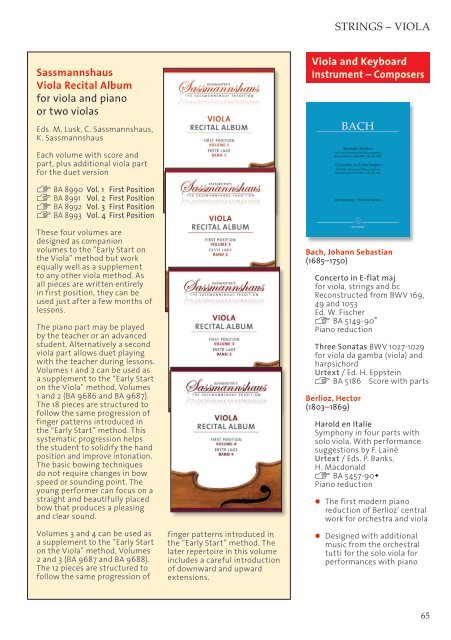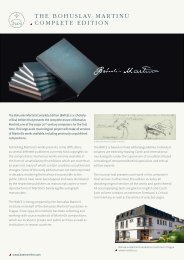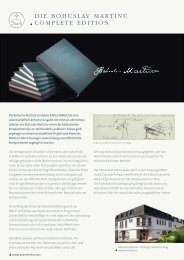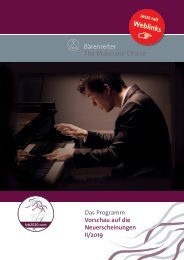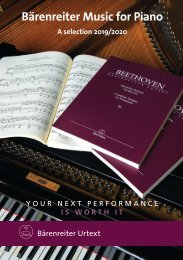SPA480_Bestseller_2019_2020_web_hoch
You also want an ePaper? Increase the reach of your titles
YUMPU automatically turns print PDFs into web optimized ePapers that Google loves.
STRINGS – VIOLA<br />
Sassmannshaus<br />
Viola Recital Album<br />
for viola and piano<br />
or two violas<br />
Viola and Keyboard<br />
Instrument – Composers<br />
Eds. M. Lusk, C. Sassmannshaus,<br />
K. Sassmannshaus<br />
Each volume with score and<br />
part, plus additional viola part<br />
for the duet version<br />
☞ BA 8990 Vol. 1 First Position<br />
☞ BA 8991 Vol. 2 First Position<br />
☞ BA 8992 Vol. 3 First Position<br />
☞ BA 8993 Vol. 4 First Position<br />
These four volumes are<br />
designed as companion<br />
volumes to the “Early Start on<br />
the Viola” method but work<br />
equally well as a supplement<br />
to any other viola method. As<br />
all pieces are written entirely<br />
in first position, they can be<br />
used just after a few months of<br />
lessons.<br />
The piano part may be played<br />
by the teacher or an advanced<br />
student. Alternatively a second<br />
viola part allows duet playing<br />
with the teacher during lessons.<br />
Volumes 1 and 2 can be used as<br />
a supplement to the “Early Start<br />
on the Viola” method, Volumes<br />
1 and 2 (BA 9686 and BA 9687).<br />
The 18 pieces are structured to<br />
follow the same progression of<br />
finger patterns introduced in<br />
the “Early Start” method. This<br />
systematic progression helps<br />
the student to solidify the hand<br />
position and improve intonation.<br />
The basic bowing techniques<br />
do not require changes in bow<br />
speed or sounding point. The<br />
young performer can focus on a<br />
straight and beautifully placed<br />
bow that produces a pleasing<br />
and clear sound.<br />
Volumes 3 and 4 can be used as<br />
a supplement to the “Early Start<br />
on the Viola” method, Volumes<br />
2 and 3 (BA 9687 and BA 9688).<br />
The 12 pieces are structured to<br />
follow the same progression of<br />
finger patterns introduced in<br />
the “Early Start” method. The<br />
later repertoire in this volume<br />
includes a careful introduction<br />
of downward and upward<br />
extensions.<br />
Bach, Johann Sebastian<br />
(1685–1750)<br />
Concerto in E-flat maj<br />
for viola, strings and bc<br />
Reconstructed from BWV 169,<br />
49 and 1053<br />
Ed. W. Fischer<br />
☞ BA 5149-90°<br />
Piano reduction<br />
Three Sonatas BWV 1027-1029<br />
for viola da gamba (viola) and<br />
harpsichord<br />
Urtext / Ed. H. Eppstein<br />
☞ BA 5186 Score with parts<br />
Berlioz, Hector<br />
(1803–1869)<br />
Harold en Italie<br />
Symphony in four parts with<br />
solo viola. With performance<br />
suggestions by F. Lainé<br />
Urtext / Eds. P. Banks,<br />
H. Macdonald<br />
☞ BA 5457-90•<br />
Piano reduction<br />
• The first modern piano<br />
reduction of Berlioz’ central<br />
work for orchestra and viola<br />
• Designed with additional<br />
music from the orchestral<br />
tutti for the solo viola for<br />
performances with piano<br />
65


